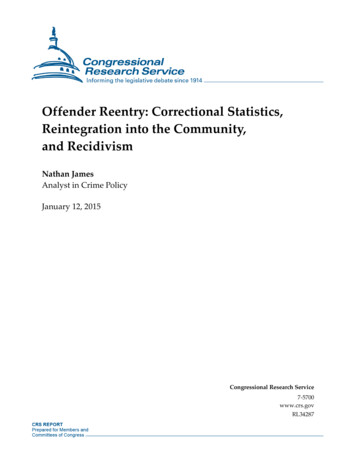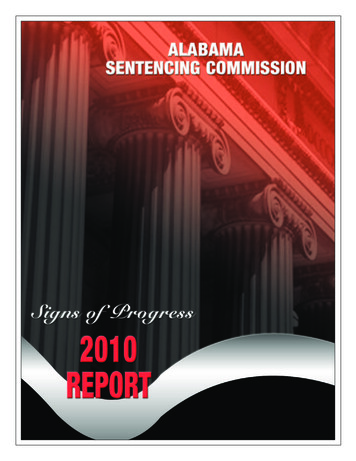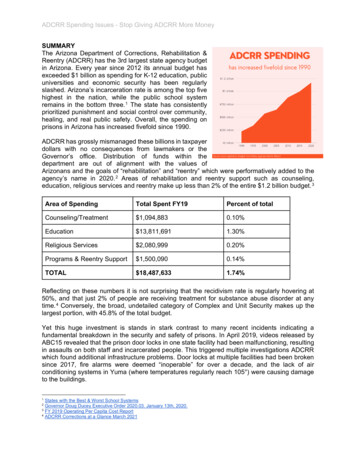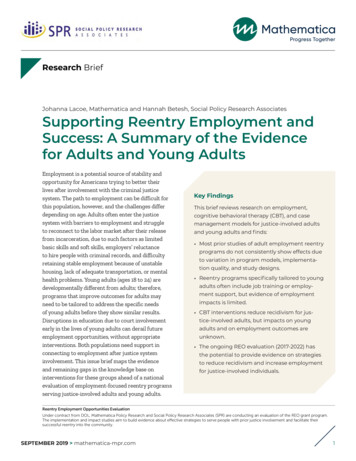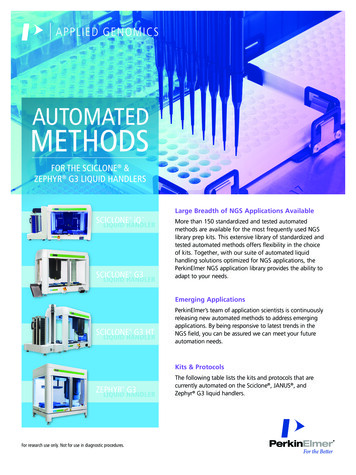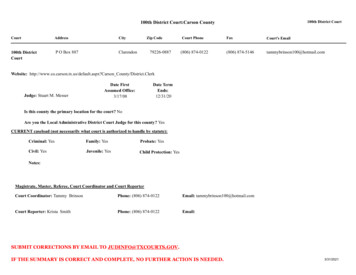
Transcription
Reentry Court Tool KitA Guide forReentry CourtPractitioners2012
Reentry Court Tool KitAcknowledgementsThis publication was supported by Grant No 2009-CZ-BX-0051 awarded by the Bureauof Justice Assistance to the Center for Court Innovation under the Second Chance Act.The Bureau of Justice Assistance is a component of the Office of Justice Programs,which also includes the Bureau of Justice Statistics, the National Institute of Justice, theOffice of Juvenile Justice and Delinquency Prevention, the Office for Victims of Crime,and the Office of Sex Offender Sentencing, Monitoring, Apprehending, Registering, andTracking. Points of view or opinions in this document are those of the author and do notnecessarily represent the official position or policies of the U.S. Department of Justice.This tool kit was written by Christopher Watler and Debbie Boar with assistance fromJillian Shagan, Robert V. Wolf, Sarah Schweig, and Lama Hassoun-Ayoub.Generous in-kind and direct support for the Center’s reentry program at the HarlemCommunity Justice Center has been provided by the New York State Department ofCorrections and Community Supervision, New York State Office of CourtAdministration, New York State Parole Board, New York State Division of CriminalJustice Services, and the J.C Flowers Foundation.About the AuthorsDebbie Boar oversees the Harlem Community Justice Center's reentry initiatives,including the Harlem Parole Reentry Court and the Manhattan Reentry Task Force. Asdeputy director, Ms. Boar designs and implements population specific, evidence-basedoffender reentry strategies, strengthens partnership among stakeholders, and providesexpert assistance to jurisdictions seeking to develop reentry programs. Prior to thisposition, Ms. Boar served as a criminal defense attorney at the Legal Aid Society of NewYork City. She received her B.A. from Haverford College and her J.D. from RutgersNewark School of Law.Christopher Watler is project director of the Harlem Community Justice Center. Mr.Watler previously served as the deputy director of national technical assistance where heprovided information and assistance on community justice initiatives to a broadaudience, by leading site visits to the Center’s demonstration projects, conductingtraining, providing hands-on assistance to jurisdictions developing community court andprosecution programs, assisting in the development of community justice curricula, andcoordinating partnerships with model community justice programs. Mr. Walter has alsoserved as part of the original planning teams for the Red Hook Community JusticeCenter and the Crown Heights Community Mediation Center. He holds a Master’s ofPublic Administration from John Jay College of the City University of New York and aB.S. in Political Science from the State University of New York College at Purchase.[1]
Center for Court InnovationTABLE OF CONTENTSINTRODUCTION .3DEFINING REENTRY COURTS .3GETTING STARTED .5 Evidence-Based Practices .5 Convening Key Stakeholders & Mapping Services .6SCREENING & ASSESSMENT .7 Determining Eligibility .7 Pre-Release Engagement .8 Client in the Community. 10 Evidence-Based Interventions . 10REENTRY COURT HEARINGS . 12 Initial Hearing . 13 Status Hearings. 14 Increased Accountability and Transparancy . 16ENGAGING FAMILY MEMBERS . 16PROGRAM EVALUATION . 17STAFFING. 18TOOL BOX . 20 Sample Planning Log . 21 Pre-Release Questionnaire . 23 Parole Supervision Plan Template . 27 List of Key Needs for Persons Released from Prison or Jail . 29 Client Incentive Protocol . 31 Harlem Parole Reentry Court Flow Chart . 32 Sample Welcome Letter . 33 Sample Job Descriptions for Key Staff . 34[2]
Reentry Court Tool KitPURPOSE OF THIS TOOL KITINTRODUCTIONThis tool kit is designed to provide guidance to justice planners in developing or enhancing areentry court using specific evidence-based practices and practices that are informed by research.The tool kit is organized around a series of topics that reentry court planners and operators oftenconfront in their work. It is informed by the work of the Center for Court Innovation, whichestablished and operates one of the nation’s first reentry courts, the Harlem Parole ReentryCourt, and convenes the Manhattan Reentry Task Force.The Harlem Parole Reentry Court started operations in 2001 as one of the first reentry courtsfunded under a U.S Department of Justice grant program. The reentry court model borrows fromthe growing literature about the effectiveness of drug courts and the role judicial monitoring canplay to improve offender compliance. The Harlem Parole Reentry Court model combinescomprehensive case management, pre-release engagement and judicial monitoring focused onparolees returning to a specific geographic area, Harlem—one of New York State’s high impactprisoner reentry communities.In 2009, the reentry court was award a Second Chance Act grant. Grant funds have been used toincorporate several evidence-based program components and to evaluate the effectiveness of theprogram. Staff engaged in a 12-month enhancement planning process that included retooling ofworkflows, hiring and training of new staff, and securing the necessary Institutional ReviewBoard approvals for the evaluation plan. Currently, the program is staffed by four parole officers,a senior parole officer, and an administrative law judge all provided by the New York StateDepartment of Corrections and Community Supervision and Parole Board. A programcoordinator, four case managers/social workers, and a cognitive behavioral therapy groupfacilitator are funded under the Second Chance Act grant to provide direct services to 200 highand moderate-risk parolees returning to Harlem annually.DEFINING REENTRY COURTSThe reentry court model emerged in the 1990’s as an alternative approach to traditionalparole/probation supervision. The United States Department of Justice funded the first nine pilotreentry court projects in 2001 based in part on the success of other alternative court models,particularly drug courts. Jeremy Travis, who first raised the idea of reentry courts,1 describesreentry courts as “a new way to coordinate available services . By placing a judge (or[3]
Center for Court Innovationmagistrate) in the role of reentry manager, these courts, which draw upon the successes of drugcourts and other problem-solving courts, create a different relationship between returningprisoners and the criminal justice system.”2Prison and jail reentry has garnered local and national attention due in part to the rising cost ofincarceration and evidence that mass incarceration policies have not produced durable publicsafety gains. In 2009, when the first round of Second Chance Act grants was awarded, there wereover 1.6 million people incarcerated in state and federal prisons—a rate of 502 inmates for every100,000,3 the highest level in the developed world. While the United States remains the worldleader in incarceration, the tide has begun to shift in the past few years towards evidence-basedpractices that cost less than incarceration and are more effective at promoting desistance fromcrime.The reentry court model uses judicial monitoring with community supervision strategies thatfocus on reducing recidivism. The involvement of a judge increases accountability among thereentry team and has the potential to improve services and positively impact perceptions ofprocedural fairness linked to improved compliance.While dozens of reentry court projects are in planning or operation in the United States, there arefew sources of information available to reentry court planners and staff to guide them indeveloping effective projects.[4]
Reentry Court Tool KitGETTING STARTED Evidence-Based PracticesIt has become commonplace to hear the term “evidencebased practices” in connection with criminal justiceprogramming. The Center for Effective Public Policydefines evidence-based practices as “the application ofempirical research to professional practice.” Theresearch must be based on “rigorous studies that havebeen replicated numerous times with defined,measurable outcomes about the effectiveness of anintervention.” In the context of prison or jail reentry,evidence-based practices have been developed that seekto improve client outcomes, reduce recidivism, andlower justice system costs.ResourceImplementing Evidence BasedPractices,” a Coaching Packetpublished by the Center forEffective Public Policy can be foundonline idence%20Based%20Practices.pdfEvidence-based programs use a practice or set of practices in a structured process of delivery thathas been validated as consistently able to achieve specific outcomes. While evidence-basedprograms work, far too few have been implemented effectively and scaled up. Evidence-basedpractices and programs require a high degree of fidelity to the model and, in some cases, can beexpensive to implement. Programs that use evidence-based practices have a greater chance ofsuccess, and of attracting funding.Reentry courts should seek to adopt evidence-based practices whenever possible. However,when adopting an evidence-based practice or program is not possible, reentry courts should usethe available evidence to inform and innovate. It is fair to say that reentry courts are stillexperimental. They borrow heavily from research on drug courts, but have not yet had enoughresearch behind them to indicate that they are consistently effective at achieving reductions inreoffending. Reentry courts do use evidence-informed approaches like judicial monitoring andthe use of incentives to motivate behavior change. These strategies may in the future developmore evidence that suggest they are effective with persons returning from prison or jail.For new or existing reentry court programs, a planning team should explore the literature onevidence-based practices in reentry and determine which practices might enhance programming.A good place to start is considering how the reentry court will measure client risks and needs.Some jurisdictions have created their own validated risk assessment instrument, while others usetools created by third parties. Teams can check with their state’s corrections/communitycorrections agency to determine if it has a risk assessment instrument currently in use. The state[5]
Center for Court Innovationmay also have a license for a third-party assessment tool, like the COMPAS,4 for use at minimalor no additional costs. Convening Key Stakeholders & Mapping ServicesConvening a reentry working group or task force is often a first step towards leveragingresources to start or re-tool a reentry court program. Private and government funders are morelikely to fund projects where there is an existing local reentry service coordination effort. Thereis no need to reinvent the wheel; in some cases a reentry sub-committee can be developed as partof an existing crime strategy or service collaboration.TipsExample Invite the senior leadership from potentialThe Office of New York County Districtpartnering agencies and organizations toAttorney Cyrus Vance Jr. serves as a coparticipate in the task force. It may not bechair of the Manhattan Reentry Taskpossible to keep a senior executive involvedForce. It works collaboratively with thein the day-to-day development of theNew York State Department ofproject beyond the initial stages, so work toCorrections and CommunitySupervision and the Harlem Communitymake sure surrogates have a direct line toJustice Center to implement effectivesenior decision makers.reentry programs as part of the Office’s Engage the local prosecutor. Prosecutorscrime reduction strategy.can bring attention to effective reentry worklocally and can use their offices to help getrelevant players to the table. When planning a reentry court, determinethe target community using crime data, corrections data, and qualitative feedback fromkey community stakeholders. Identify key local resources, especially in the areas of housing, drug treatment, andemployment. Consider using AmeriCorps volunteers or student interns to map localservices. Service mapping identifies available services in a geographic area and anypotential barriers to access. The process can involve both online and on-the-groundresearch. Faith-based service providers and voluntary groups that are not receivinggovernment funds may not appear on official government web sites or resource guides,so canvassing by foot is often the best way to learn about their existence. This approachis also helpful in identifying community assets like cultural resources and parks andfamily venues that formerly incarcerated clients might access to support their reentryprocess. Use a planning log to track program development activities. Logs not only track progressbut also capture information for grant reporting. The log should record informationrelated to the project’s funded goals as well as other program development goals.[6]
Reentry Court Tool KitResourcesGoogle Maps has a free feature to create maps. You can chose to share the maps publicallyor only with persons to whom you send a link. Learn more about how to use Google Mapshere: http://www.morethanamap.com/The U.S. Department of Labor’s Service Locator is a resource that provides information onemployment programs by state and zip ol Box: Sample Planning Log, p. 21SCREENING & ASSESSMENT Determining EligibilityIt is critical to develop reentry court eligibility requirements that focus on medium to high-riskpersons while limiting enrollment of low-risk persons with low service needs. Research showsthat targeting too many interventions at lower risk populations can actually increase their risk ofrecidivism. A retrospective evaluation of the Harlem Parole Reentry Court suggests that thereentry court approach works best for persons on parole requiring intensive supervision andservices, first-time parolees, and people who are drug addicted.5 Reentry courts should useactuarial risks and needs assessment prior to release to inform community supervision planning.States may develop their own evidence-based assessment tools or use third party assessmenttools specifically developed to determine an individual’s risk of re-offending and needs.Assessment tools include COMPAS (Correctional Offender Management Profiling forAlternative Sanctions) and the LSI-R (Level of Service Inventory-Revised).The Harlem Parole Reentry Court uses two tools to screen each individual’s risk level. First,before accepting a participant into the program the senior parole officer determines if thepotential participant is medium to high risk using a validated risk score generated by New YorkState. This risk score is based on static factors like gender, age of the person at arrest, andcriminal background. Once accepted into the program, the COMPAS tool is administered byreentry court staff either pre-release or soon after release to provide a more nuanced assessmentof the client.[7]
Center for Court InnovationThe COMPAS assessment results are used to guide case planning and prioritize client needs aswell. The COMPAS assessment and pre-release client engagement provides a clear picture of thespecific criminogenic needs that have to be addressed to lower clients’ risk of recidivism. Forinstance, participants who score high on the “criminal personality” criminogenic factor may berequired to enter a cognitive behavioral change program or engage in one-on-one counseling thatfocusing on problem solving, identifying and managing emotional responses, and developingcoping skills. Interactions with corrections staff, the judge, and case management staff are usedto reinforce the new skills the individual learns. Individualized case plans take into account thebest strategy for targeting the participant’s criminogenic needs.Tips What are Criminogenic Needs?Depending on crime data, the greatest areaof need, and logistics, you might select agroup of offenders that are: 1) returning to asingle geographic area, 2) being releasedfrom one correctional facility, 3) beinghoused together, 4) who have beenconvicted of a certain type of crime (i.e.violent felony offense, etc.), and/or 5) whoare members of a “special population,” suchas young adults ( ages18-26).Make sure staff is trained to use yourassessment tool and that monitoring of theassessment process is a part of ongoing staffsupervision. Written protocols should bedeveloped to guide staff on how to useassessment tools.According to the Center for EffectivePublic Policy, Criminogenic Needsare factors that research has shownto be directly related to re-offendingand can be changed. The top 8 needsare referred to as “The Great Eight:”1) history of anti-social behavior, 2)anti-social personality patterns, 3)antisocial attitudes cognition, 4) antisocial peers, 5) poor familyrelationships, 6) pooreducational/vocation achievement,7) lack of pro-social/leisureactivities, and 8) substance abuse.The Need Principle Pre-Release EngagementWe can only decrease clients’ risks if weunderstand what their needs are and thentarget them through interventions. Not allclients’ needs equally influence theirlikelihood to recidivate. High-risk offenderstend to have multiple needs and score highon the most crime-producing needs, such asanti-social behavior and anti-socialattitudes. Using a risk assessment tool likethe COMPAS helps to identify the specificcriminogenic needs of reentry court clients.Pre-release engagement affords the casemanager and parole/probation officer anopportunity to begin establishing the clinicalrelationship at a moment when the individualmay be most receptive to assistance andsupport. Pre-release engagement should begin30 to 60 days prior to an inmate’s release. It isimportant to leave enough time to addresscritical needs prior to release, while avoidinga lot of work early on with a client who might[8]
Reentry Court Tool Kithave his or her release date extended or canceled due to an infraction. During this time, staff canoffer the participant individual attention that capitalizes on the client’s hopes and plans for a newbeginning. The case worker or parole/probation officer also has the opportunity to listen andempathize with some of participant’s anxieties about returning to the community.For example, many participants are ambivalent about the relationship with the parole/probationofficer who will supervise them in the community. Most participants haven’t had many positiveexperiences with law enforcement or parole/probation officers, much less a judge, andinstinctually interact with them in a defensive manner, an attitude that can negatively influencetheir community supervision process. Using pre-release meetings as an opportunity to exploresome of these concerns with the individual can reduce defensiveness and support a more trustfuland problem-solving relationship that the client can continue to develop once released.Pre-release engagement also allows the case manager or parole/probation officer to beginconnecting the individual with supportive services. Every individual returning to the communityunder parole supervision in New York must abide by conditions of release, a set of statemandates the participant is required to follow. These may include, for example, substance abusetreatment, educational or vocational programs, or anger management.An individual returning home after several years of incarceration may feel overwhelmed with theprospect of identifying a treatment provider or enrolling into vocational or educational programs,while also attempting to reunify with their family members and pursuing self-identified goals.Pre-release meetings provide an excellent opportunity to discuss conditions of release, learnabout the client’s own goals, and set up referrals in advance. Upon release, the individual willimmediately be attached to programming that will keep them focused and occupied during thisparticularly risky transition period.Tips: The Harlem Parole Reentry Court uses a strength-based pre-release questionnaire to helpguide discharge planning. The tool helps case management and social work staff focus onkey information about the participant’s strengths and challenges. It is important toaddress reentry court participant stabilization needs as soon as possible, includingobtaining proper identification cards, public assistance, and housing. Without addressingthese needs, it’s impossible to begin tackling the criminogenic needs of the participant. Make sure each client has a copy of his or her release papers. They often can be used toget identification when clients have no other way of securing an ID.[9]
Center for Court Innovation Client in the CommunityOnce released, participants report to theHarlem Parole Reentry Court to make theirfirst report to the parole/probation officer andto schedule an intake meeting with the casemanager. At the intake meeting, staff workwith the participant to complete a risk andneeds assessment and to finalize his/hercommunity supervision plan. The communitysupervision plan maps out how the individualwill accomplish parole mandates withprogramming while pursuing individual goals.ResourceThe Legal Action Center’s Advocacy ToolKit offers advice for helping clients withcriminal convictions to D/ID.htmA one size fits all reentry model is not effective. Harlem Parole Reentry Court participants are adiverse set of individuals with varied ages, cultures, levels of cognition, interests, and lifeexperiences. Instead of simply assigning an individual to a program, we ask: When do you feelmost happy? What motivates you to get up in the morning? In what type of setting do you feelmost comfortable?For a client who answers that his kids are most motivating, we might suggest a work programthat includes parenting training and family outings. For a participant who has experienced asignificant amount of trauma, we might recommend a trauma-focused program. For a gangmember trying to stay away from former associates, we will make sure to choose programmingaway from rivals. For someone that has low literacy skills, but has a long-term goal of going tocollege, we might recommend an educational program that offers everything from pre-GEDclasses to college prep.The research literature indicates that services must be tailored to the risk and need levels of eachparticipant and must be delivered in a high-quality manner to support participant success. TheHarlem Parole Reentry Court flags high-risk and high-need cases based on the COMPAS orparole officer recommendation for more intensive services and supervision. Staff will reach outto high-risk and high-need clients more frequently, make home visits, hold regular skill buildingor counseling sessions, or, when appropriate, mandate cognitive behavioral therapy or one-onone counseling sessions to address criminal thinking. Evidence-Based InterventionsAs part of the Harlem Parole Reentry Court’s programming a 22-session evidence-basedcognitive behavioral intervention program is offered to as many high-risk participants aspossible. The program is a structured time-limited intervention that works with clients to identifyand change thoughts and attitudes that lead to risky behavior and to practice healthy behaviors[10]
Reentry Court Tool Kitassociated with achieving the outcomes clients’ desire. The New York State Department ofCorrections and Community Supervision allow the reentry court’s cognitive behavioral therapycurriculum to fulfill the state’s anger management treatment mandate, which is required of manyparolees.6Another evidence-based practice used by Harlem Parole Reentry Court staff members ismotivational interviewing. It is a client-centered, strength-based counseling approach designed tohelp clients elicit and strengthen the motivation for change.7 The motivational interviewingembraces three core elements: collaboration, which fosters a partnership between the client andpractitioner; evocation, which brings out the client’s internal motivation, as opposed to tellingthe client why he should change; and autonomy, which is an acknowledgement that theparticipant has the ability to determine how he will act. In the Harlem Parole Reentry Court, staffuses motivational interviewing to reinforcepositive behavior and promote self-efficacy. Inline with motivational interviewing, staffResourcesrecognizes that resistance is part of the processof change, and understands that confrontation orThe National Institute of Corrections hasfighting with participants only serves to buildonline motivational interviewing curriculaand resources. See: http://nicic.gov/resistance. Instead, clients are engaged with“change-talk” and challenged to addressToolbox: Parole Supervision Planpersonal discrepancies and distortions, whileTemplate, p. 27providing firm and non-judgmental support.Case managers consistently offer encouragingToolbox: Some Key Needs for Personsfeedback and support in an effort to motivateReleased from Prison or Jail, p. 29clients as they adopt more pro-social lifestyles.When clients are successful in their endeavors,staff acknowledge their efforts.While the Harlem Reentry Court team provides many services to our participants, we alsodepend heavily on our network of community providers. We begin our relationships withoutside providers by inviting them to our macro-team meeting where they inform us of theirservices. If our team believes the organization shares a similar philosophy, provides qualityservices, and is open to communication, we will follow up this meeting with a site visit. Once wehave fully vetted a program and determined that it may fill a need of our clients, we will beginreferring clients there. Frequently, we will reach an agreement with a provider that uponreaching a number of referrals, a representative from that organization will attend the monthlymacro-team meeting. As clients may be enrolled in multiple treatment programs, participation inregular macro meetings allows for a holistic discussion of the clients engagement and anyprogrammatic conflicts that may be impacting them. In some circumstances, we will inviteoutsider providers to do intakes on site at the Justice Center during the parolees report day andcase conference with members of the team including the judge, the parole officers, and clinicalstaff.[11]
Center for Court InnovationTips: Use motivational interviewing and cognitive behavioral approaches to establish aneffective working alliance with the participant that is strength-based, goal-oriented andskill-driven. If possible, train all reentry court staff on the use of motivational interviewing andcognitive behavioral therapy to develop a common understanding on the team of theskills and promote consistent use of these evidence-based practices. Parole/probation staff and clinical staff might also consider meeting with participantstogether during their regular parole/probation check-in meetings. These joint meetingsensure that everyone shares an understanding of the participants’ progress or challenges,and that the clinical worker can address issues with the participant that arises during themeeting.REENTRY COURT HEARINGSReentry court hearings are focused on promoting compliance with court mandates, increasingparticipant accountability, offering positive reinforcement, and altering the participant’sperceptions of the justice system through respectful interactions between the judge and theparticipant. Hearing
comprehensive case management, pre-release engagement and judicial monitoring focused on parolees returning to a specific geographic area, Harlem—one of New York State's high impact prisoner reentry communities. In 2009, the reentry court was award a Second Chance Act grant. Grant funds have been used to

